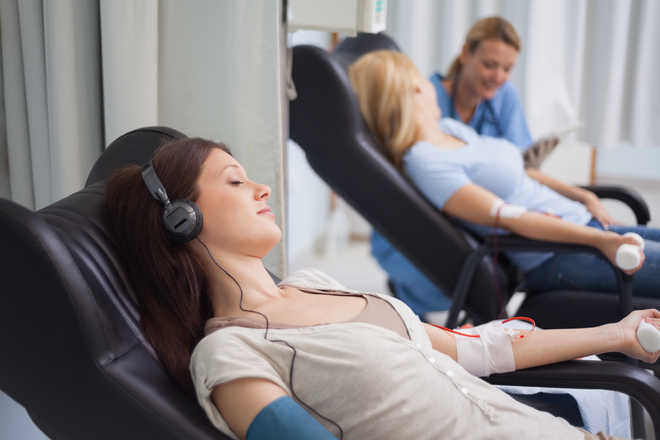
Thinkstock
Surekha Kadapa-Bose
None of Aamla’s efforts to calm down the little one seemed to be working. As she found herself at her wits’ end, something prompted her to play an old Mohammad Rafi song. To her surprise, not only did Noor stop howling but also started gurgling merrily. This was the song she would often listen to during pregnancy — while driving home from work in Bengaluru or rustling up dinner. Did Noor recognise the song? Whatever the answer, Aamla now often finds herself falling back on the song to calm down the little one whenever she is cranky.
To keep her 18-year-old autistic child engaged while she goes about attending to everyday chores, Lucy prefers to play Michael Jackson in the house. “The hour-long album gives me enough time to do my work without the fear of Augustine hurting himself, trying to jump off the chair or running around. While the CD plays, he is busy dancing, singing and playing without the need for my supervision,” says the homemaker from Mumbai.
Similarly, MS Subbulakshmi’s melodious voice comes to Kumar’s aid whenever he has to take care of his octogenarian father, who is suffering from the Alzheimer’s disease.
For long, music has been recognised as an effective form of therapy to provide an outlet for emotions, but its use in hospitals is a relatively new domain. Soothing music, which was so far restricted to homes, drives or morning walks, is swaying into the alleys of hospitals, sanatoriums, etc. to provide succour to the ailing. Many hospitals in the country have started playing soft music — either instrumental or devotional — in the background. Strains of tranquil music can be heard in the wards with victims of depression and anxiety as well as neonatal wards, ICUs (intensive care units) and ICCUs (intensive cardiac caring units).
“Many a time, we use music along with other therapies, especially when treating patients of depression and anxiety,” says Dr Sameer Malhotra, senior psychiatrist at Max Super Specialty Hospital, New Delhi.
Elaborating on the use of music as a non-threatening tool for interventions, Dr Malhotra adds, “Relaxation boosts immunity, and this, in turn, aids any other treatment the patient may be undergoing.”
Studies have shown evidence of music’s anti-anxiety properties and its association with higher levels of immunoglobin A, an antibody linked to immunity. The brain’s reward centre responds to music and a brain structure called the striatum releases dopamine, a chemical associated with pleasure.
Experts say this especially helps in the ICUs and ICCUs as beeping of monitors can be unnerving and disturbing. In order to camouflage these, sounds of santoor, sitar, shehnai, or even guitar, are now calming the nerves of patients. In the case of differently-abled children, especially those afflicted with the Down’s syndrome, autism, ADHD and low IQ, hospitals and counsellors have found evidence that dance and drawing therapies show a positive reinforcement of appropriate behaviour and act as a motivator to reduce negative ones. Verbally, these people may not be able to communicate, but dancing and sketching make it easy for them to express, in turn, helping doctors, caretakers and parents understand them better.
Dr Snehlata Deshmukh, Mumbai-based paediatric surgeon and former vice-chancellor of Mumbai University, known for her work in the city’s neonatal units, says that even a six-month-old foetus responds to music.
“While performing sonography, we are able to read the emotions of the baby in the womb — Is the baby uncomfortable, comfortable, happy or sad, etc? We have found that from six months onwards, the foetus responds to melodious music. This has made us recommend 15-minute sessions of soft music to pregnant mothers twice a day. We have observed that this calms down the baby in the womb and helps it gain weight as the sucking of amniotic fluids increases in a relaxed foetus,” explains the veteran gynaecologist.
In studies conducted at Mumbai’s KEM Hospital, Dr Deshmukh and her team noticed change in the weight of premature babies in incubator in the hospital’s neonatal department. Two groups of babies were fed the same food and medicines, but one of them was exposed to soft Indian classical music. Results were startlingly different. “Babies exposed to music gained weight considerably, unlike the other group. We deduced that increasing rhythm or taal of classical ragas played in the background increased the sucking speed of the babies, and hence the weight gain!”
Such experiments do reinforce that soothing music helps both calm and stimulate. Even in day-to-day life, we find our heartbeats attuned to a particular kind of sound and music. Our heartbeat responds to flexible frequency, tempo or volume of the sound. The faster the beat of the music, the more rapidly our heart beats.
Dr Deshmukh explains that though her experiments may lack scientific evidence, her observations have been of great help to her patients. “I even recommend the chanting of Om in a slow tempo. I often demonstrate to patients the way to recite it properly. I have received positive feedback,” she says.
The Lucknow-based Centre of Biomedical Research at Sanjay Gandhi Postgraduate Institute of Medical Sciences has studied in detail the effect of the sound of Om on the neural cortex of the brain. With the aid of MRIs and other imaging of brain activities, positive changes were observed in people chanting Om compared to those chanting other spiritual words.
However, physicians do warn that these aren’t standalone therapies and have to be used in conjunction with other medication and treatment, and only after consultation with one’s physician.
Gigs at hospital
In the West, live performances by musicians are becoming popular in hospitals. Don’t be surprised if you encounter a guitar-strumming musician in a children’s ward or someone singing to elders in hospitals in the USA, the UK and other countries.
Yoga therapy
Another form of therapy that has entered the portals of hospitals is yoga. Even physiotherapists recommend asanas to those suffering from orthopaedic problems. In most metro cities, many pregnant women attend yoga workshops to help them get through the nine months of mood swings, fatigue, morning sickness, leg cramps, and even breathing problems associated with pregnancy. Asanas like vakrasana, utkatasana, parvatasana, etc. are recommended, but with due care and consultation.



























